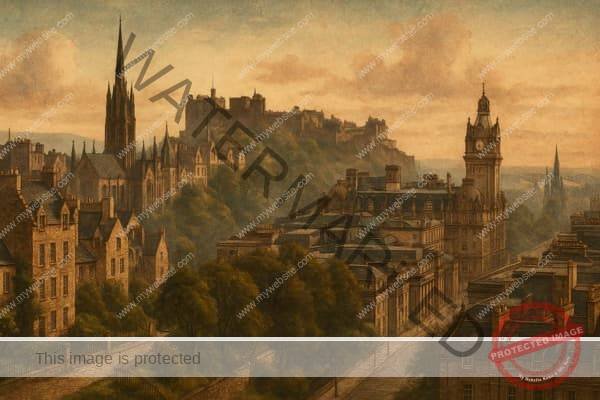What Is a World Heritage Site Anyway?
If you’ve ever stood in a place and felt the weight of centuries settle around your shoulders, chances are, you’ve been somewhere exceptional. A World Heritage Site (WHS) is precisely that: a place recognised by UNESCO (the United Nations Educational, Scientific and Cultural Organisation) as possessing “Outstanding Universal Value” — meaning it’s important not just to one country but to the whole world.
Scotland is known for its rich history, stunning landscapes, and remarkable human accomplishments.
Scotland’s home to a remarkable collection of World Heritage Sites — from the ancient stones of Orkney to the mighty Forth Bridge. They’re celebrated across the globe for their cultural, historical, or natural importance. But here’s the thing: just because they’ve made the list doesn’t mean they’re safe forever.
These places still face change, challenges, and risks — and they need our care to keep them special.
Take Edinburgh, for example — the Old and New Towns are a masterpiece of urban planning and architecture, celebrated for their contrast between medieval winding closes and grand Enlightenment-era crescents. However, they must be cherished and carefully managed to maintain that UNESCO status. Overdevelopment, neglect, or insensitive alterations could see that recognition slip away — and with it, a particular kind of pride.
Explore all six of Scotland’s World Heritage Sites — not as museum pieces, but as living places with stories, challenges, and a place in both our past and our future.
Scotland’s Six World Heritage Sites
The Heart of Neolithic Orkney
Step back 5,000 years to one of Europe’s best-preserved prehistoric landscapes. This site includes Skara Brae (a stone-built village older than the pyramids!), the ceremonial Ring of Brodgar, the Stones of Stenness, and the grand tomb of Maeshowe. These monuments offer a stunning glimpse into a sophisticated Neolithic culture that knew how to build — and had the mysteries to match.
St Kilda
A hauntingly beautiful archipelago far out in the Atlantic, St Kilda is the UK’s only mixed World Heritage Site—recognised for its cultural history and incredible natural environment. Abandoned by its small population in 1930, it’s now home to Europe’s largest seabird colony, including puffins and gannets galore. Remote, rugged, and unforgettable, it is also home to the world’s largest seabird colony, including puffins and gannets.
The Old and New Towns of Edinburgh

This is a story of two cities in one: the medieval labyrinth of the Old Town, with its narrow alleys and winding paths, and the Georgian elegance of the New Town, characterized by sweeping crescents and Enlightenment ideals expressed in stone. Together, they create a unique cityscape.
But as beautiful as it is, it’s also vulnerable — over-tourism, modern development, and infrastructure strain are genuine threats. Cherishing it means managing it with care.
New Lanark
On the banks of the Clyde sits a visionary 18th-century mill village where industrial progress met social reform. Under the guidance of Robert Owen, New Lanark became a beacon of fair work conditions, education, and cooperative living. It’s a testament to what industry can be when humanity is at its core.
The Antonine Wall
Rome’s final frontier in Britain, this turf-and-timber wall stretches across the Central Belt from the Firth of Forth to the Firth of Clyde. Built around 142 AD and abandoned just two decades later, the Antonine Wall is part of the UNESCO World Heritage Site, “Frontiers of the Roman Empire.” Today, it’s a quiet, grassy whisper of empire and an excellent excuse for a historic hike.
The Forth Bridge
The Forth Bridge is a remarkable example of Victorian engineering and one of the most iconic bridges in the world. More than a century after its opening, it continues to carry rail passengers across the Firth of Forth. Its striking red cantilever design is celebrated as one of the world’s eight wonders and remains a breathtaking sight.
The Flow Country (Inscribed in 2023)
Spanning Caithness and Sutherland in the far north of Scotland, the Flow Country is one of the world’s most significant areas of blanket bog — and a vital natural carbon sink. This vast, almost otherworldly landscape is alive with peatlands, pools, mosses, and curlews.
The Flow Country plays a significant role in climate regulation and biodiversity. It is a unique example of a natural World Heritage Site in the UK. The Flow Country reminds us that heritage isn’t only created from stone; it is also nurtured, protected, and valued within the living fabric of the land.
Keeping the Past Alive
Scotland’s World Heritage Sites aren’t relics locked behind glass — they’re living landscapes, working cities, and fragile islands where stories unfold. Each site reminds us of the brilliance, resilience, and imagination of those who came before us. But with that honour comes a shared responsibility.
Whether preserving Skara Brae’s quiet dignity, protecting seabirds on St Kilda, or carefully guiding change in Edinburgh’s historic centre, these places need care, conversation, and sometimes even a little campaigning to survive for future generations.
So, whether you’re planning a road trip, a city break, or just exploring Scotland through your screen, take a moment to reflect on the sheer wonder of what’s on our doorstep.
A World Heritage Site reflects not only our past but also our present values and the importance we place on them today.
